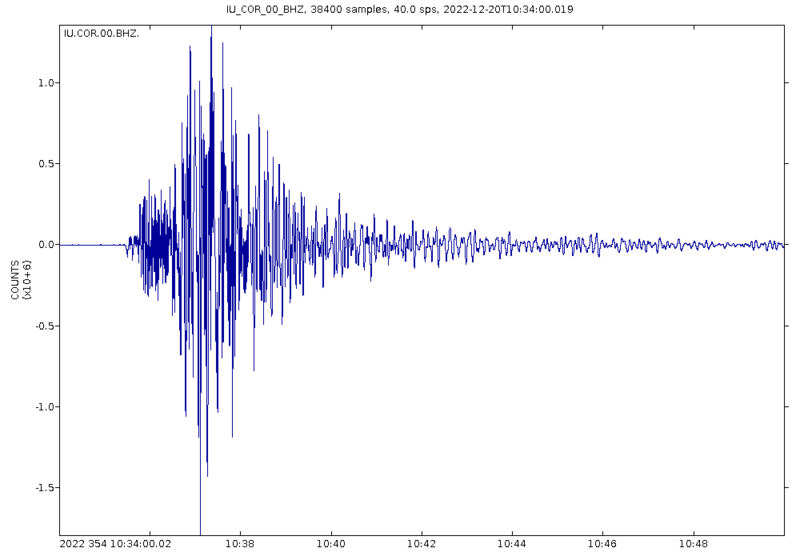File:Offshore northern California magnitude 6.4 earthquake (2-34 AM, 20 December 2022).png

Original file (1,000 × 700 pixels, file size: 685 KB, MIME type: image/png)
Captions
Captions
Summary[edit]
| DescriptionOffshore northern California magnitude 6.4 earthquake (2-34 AM, 20 December 2022).png |
English: This is a seismogram from the Corvallis seismic station in Oregon, USA. The noise was caused by a magnitude 6.4 earthquakes that hit just offshore from northern California at 2:34 AM, local time, on 20 December 2022. The epicenter was about 12 kilometers southwest of Ferndale, California. The hypocenter was between 10 and 20 kilometers deep. Shaking resulted from strike-slip movement.
Info. at: earthquake.usgs.gov/earthquakes/eventpage/nc73821036/exec... An earthquake is a natural shaking or vibrating of the Earth caused by sudden fault movement and a rapid release of energy. Earthquake activity is called "seismicity". The study of earthquakes is called "seismology". The actual underground location of an earthquake is the hypocenter, or focus. The site at the Earth's surface, directly above the hypocenter, is the epicenter. Minor earthquakes may occur before a major event - such small quakes are called foreshocks. Minor to major quakes after a major event are aftershocks. Most earthquakes occur at or near tectonic plate boundaries, such as subduction zones, mid-ocean ridges, collision zones, and transform plate boundaries. They also occur at hotspots - large subsurface mantle plumes (Examples: Hawaii, Yellowstone, Iceland, Afar). Earthquakes generate four types of shock waves: P-waves, S-waves, Love waves, and Rayleigh waves. P-waves and S-waves are body waves - they travel through solid rocks. Love waves and Rayleigh waves travel only at the surface - they are surface waves. P-waves are push-pull waves that travel quickly and cause little damage. S-waves are up-and-down waves (like flicking a rope) that travel slowly and cause significant damage. Love waves are side-to-side surface waves, like a slithering snake. Rayleigh waves are rotational surface waves, somewhat like ripples from tossing a pebble into a pond. Earthquakes are associated with many specific hazards, such as ground shaking, ground rupturing, subsidence (sinking), uplift (rising), tsunamis, landslides, fires, and liquefaction. Some famous major earthquakes in history include: Shensi, China in 1556; Lisbon, Portugal in 1755; New Madrid, Missouri in 1811-1812; San Francisco, California in 1906; Anchorage, Alaska in 1964; and Loma Prieta, California in 1989. |
| Date | |
| Source | https://www.flickr.com/photos/jsjgeology/52575602303/ |
| Author | James St. John |
Licensing[edit]
- You are free:
- to share – to copy, distribute and transmit the work
- to remix – to adapt the work
- Under the following conditions:
- attribution – You must give appropriate credit, provide a link to the license, and indicate if changes were made. You may do so in any reasonable manner, but not in any way that suggests the licensor endorses you or your use.
| This image was originally posted to Flickr by James St. John at https://flickr.com/photos/47445767@N05/52575602303. It was reviewed on 20 December 2022 by FlickreviewR 2 and was confirmed to be licensed under the terms of the cc-by-2.0. |
20 December 2022
File history
Click on a date/time to view the file as it appeared at that time.
| Date/Time | Thumbnail | Dimensions | User | Comment | |
|---|---|---|---|---|---|
| current | 13:50, 20 December 2022 |  | 1,000 × 700 (685 KB) | Kencf0618 (talk | contribs) | Uploaded a work by James St. John from https://www.flickr.com/photos/jsjgeology/52575602303/ with UploadWizard |
You cannot overwrite this file.
File usage on Commons
There are no pages that use this file.
File usage on other wikis
The following other wikis use this file:
- Usage on de.wikipedia.org
- Usage on en.wikipedia.org